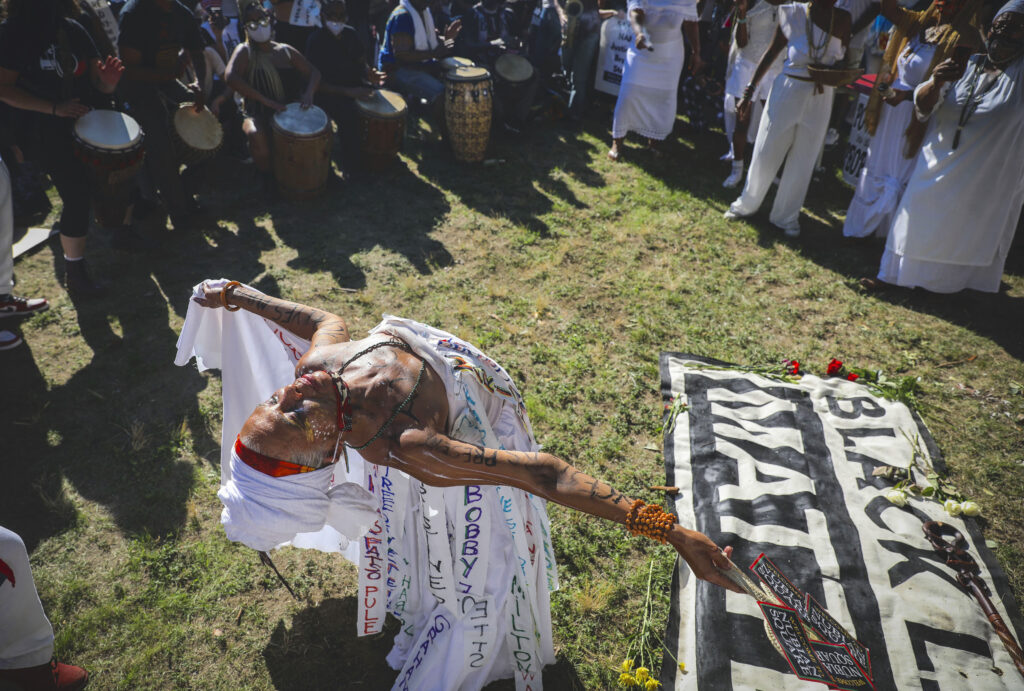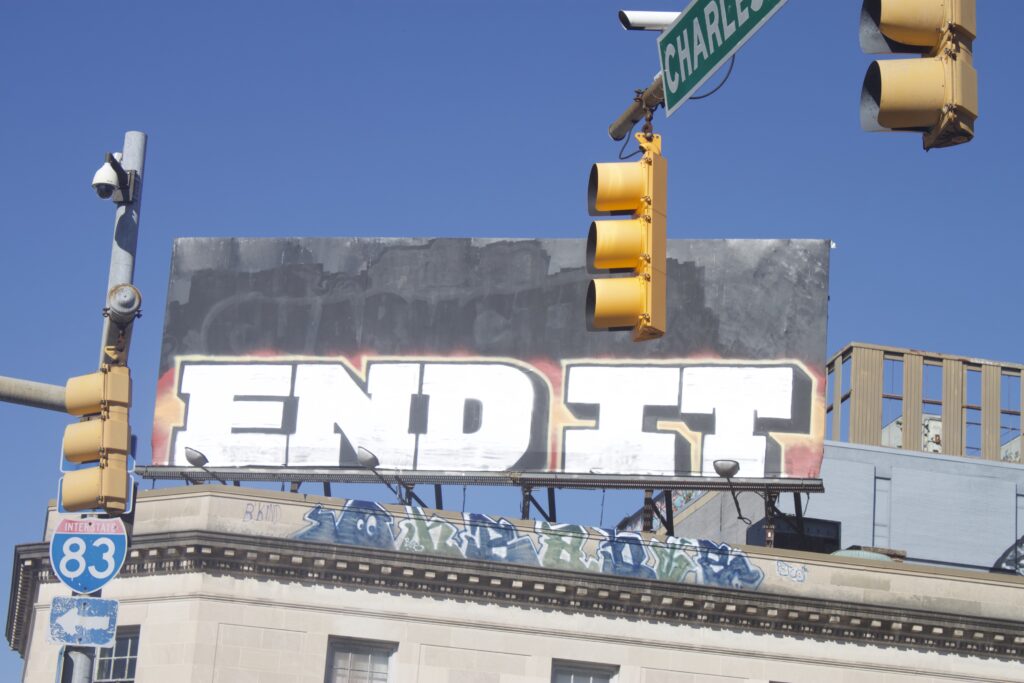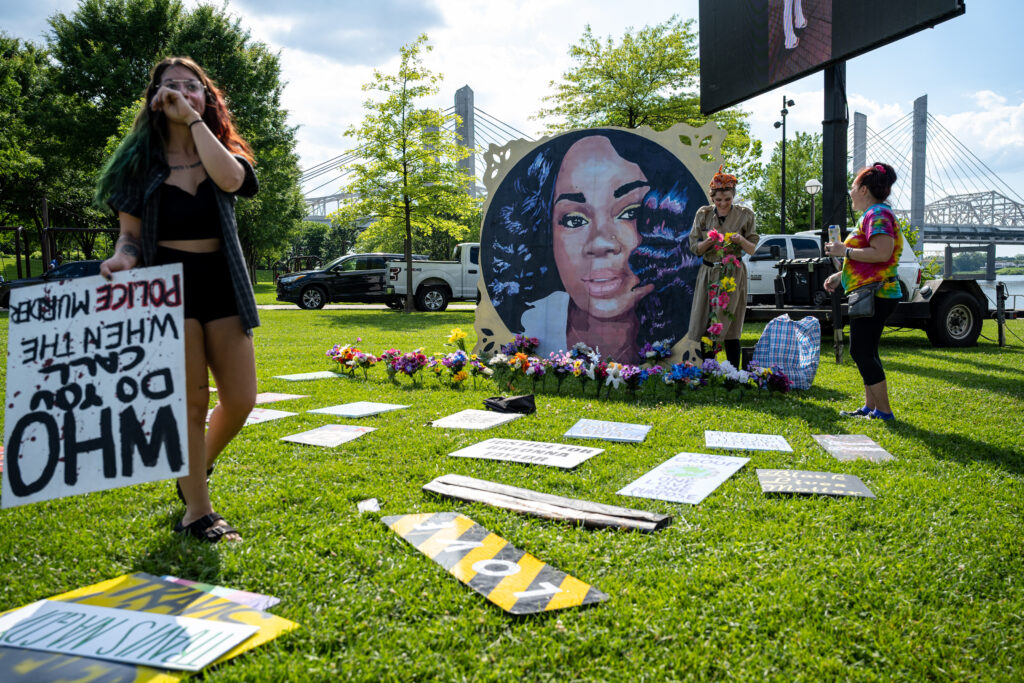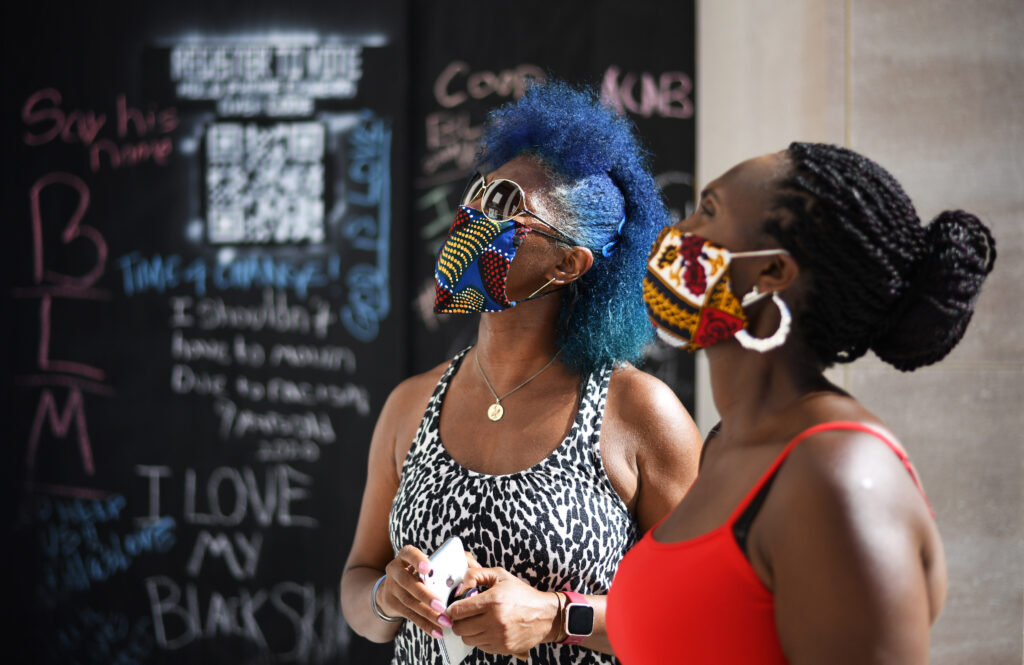The Urgency of Envisioning a World Without Police

Jeri Hutton Green and her mother Lillian Herndon talked on the phone every day. So, when Green received a text message from her mother’s number on April 10, 2020, saying she was on vacation with her live-in boyfriend, Roderick “Erik” Griffin, Green knew something was wrong. While it wasn’t unusual for her mother to travel, Herndon did not usually communicate with her daughter by text.
In the days that followed—during the uncertain early weeks of the COVID-19 pandemic—Herndon didn’t answer her phone. Green couldn’t shake her suspicions that something terrible had happened.
Green lived in Annapolis, Maryland, and wasn’t easily able to get to Baltimore, where her mother lived. When she did finally drive to her mother’s home, she knocked on the door. No answer.
So, she reached out to Baltimore City police to conduct a wellness check. They refused, she told me, insisting that Green needed to enter her mother’s home herself. After contacting Baltimore City police four more times with little response, Green started her own missing person investigation. She collected phone numbers, names, and addresses of the people who could’ve been in contact with Herndon on April 10, the last day she was seen.
Though her intuition told her something was wrong, nothing could’ve prepared Green for what happened next: On April 21, after repeated attempts to search the house, she and her brother discovered their mother’s body in her home.
That same day, Green noticed a man riding past the crime scene in her mother’s car, which Green had reported missing. When the police eventually searched for the car—only after Herndon’s body was discovered—they found Griffin driving around in it.
He was finally arrested and confessed to murdering Herndon.
According to statements made by Griffin’s defense attorney in September 2022, Griffin got into an argument with Herndon when she tried to end the relationship and asked him to leave her home. Green reported that he said he’d rather die in jail than be homeless, so he strangled her. Prior to the trial, Griffin had explained to police that he no longer saw Herndon as human at that point. After tightly tying a bandana over her face, he bound her hands and feet, and placed her in her bedroom closet. He then sent the suspicious text to Green.
I first heard Green’s story during a training for intimate partner violence survivor advocates in March 2021. Her short hair, brown skin, and wide smile reminded me of the women I knew and loved in South Carolina, where I grew up. I was struck by her assuredness; it was obvious that she had told the story again and again to whomever would listen. Green was determined to achieve justice for her mother.
Listen here to learn more about Tynes’ work: “I Do This for You, Mom.”
I felt her pain and intense love for her mother. As a Black woman who has survived interpersonal violence, I know what it’s like to fruitlessly search for support. And as an anthropologist who studies patriarchal violence and anti-Black racism in Baltimore and beyond, I struggled to imagine what justice could look like under the current U.S. criminal punishment system. Patriarchy and white supremacy shape both gender-based violence and police violence. Built on the foundations of chattel slavery and Indigenous genocide, the criminal punishment system is not broken; it is designed to be unjust.
Considering all these things, I couldn’t help but wonder, Would justice come for Green, or for any Black person? And if it did, how?
In Baltimore City, 2020 was the deadliest year on record for women, with a total of 49 women killed—many of whom were Black. At a time when everyone was advised to shelter in place to reduce the spread of the deadly and disabling COVID-19 virus, many Black women and girls around the country were forced to live in close proximity to another dangerous force: patriarchal violence.
Herndon was among more than 19 Black women and girls who were killed in Baltimore that year.
A spokesperson from the city’s police department said an increase in intimate partner violence was part of the rise in murders of women. That summer, protests around the nation called for the world to “Protect Black Women” in response to the state-sanctioned killing of Breonna Taylor in Louisville, Kentucky, in March 2020. But many Black women’s experiences with patriarchal violence were not met with similar urgency.
Green’s story, as I learned when I interviewed her later as part of my dissertation research, mirrors the experiences of so many Black women who cry out to the world for justice and protection from violence. Rather than receiving real support from the state or our communities, we are often asked for more labor. We are asked to make our pain and violation visible and digestible for others, or we are asked to do the work of minimizing our pain so that we can continue to be in service of others.
Green recounted to me how she worked tirelessly to achieve “justice” for her mother through the system. She relocated from Annapolis to Baltimore to attend every court date. She took over the affairs of her mother’s estate. She was assigned a couple of homicide victims’ advocates, who provided no emotional or legal support. She had to fight to receive adequate mental health services as her life crumbled. The only people who showed up consistently for Green were her Black women cousins.
Ultimately, Griffin was sentenced to 40 years (with 15 years suspended), with five years’ supervised probation for second-degree murder. That was “justice” as defined by the criminal punishment system.
As you can probably imagine, that was not enough for Green. But what amount of years would be? And would that really be enough to honor her mother, who would not live to celebrate her 76th birthday?
Growing up as a Black girl in the U.S. South, I learned early on that the police were the enemy of my community, especially Black men and boys. I overheard my grandmother’s stories of the young Black women she knew who attempted to report their rapes and were treated like shit under shoes.
When I was sexually assaulted at church and at school, I was told not to report it by members of my family and fellow church members because “that would ruin lives.” When I experienced physical and sexual abuse in my adult relationships, I knew I couldn’t turn to the authorities to help me.
I didn’t want to ruin another Black man’s life by involving the police. Nor did I want to go through the humiliating intimate partner violence report process.
These processes require the person harmed to provide “evidence” of their pain to be believed. Survivors are often asked why we didn’t leave our assailant sooner. We must relive the traumatic experience over and over again when we testify about what happened. Our words, appearances, and lives are picked apart to justify the harm we experienced.
The criminal punishment system is not broken; it is designed to be unjust.
Black women who report violence to authorities often face the added layer of anti-Black misogyny. That was my experience. In college, I reported an assault from a former intimate partner to my university. Though I simply wanted access to counseling, my case was pushed to the Student Conduct Board without my knowledge or consent. The hearing that determined my academic future happened in my absence. My former partner attended the hearing, claiming I made the story up because I was upset we were no longer together. He painted me out to be an “angry Black woman,” and in the minds of the Conduct Board, I was no longer a victim of harm. Instead, they treated the case as if I were the aggressor. In the end, I was sanctioned. He received a warning and a promise that if I “ever bothered him again,” I would be suspended or expelled.
After each of these violating experiences, all I wanted was to access resources that would restore my sense of integrity and safety. I wanted to feel like my body was my own. But a system designed to treat bodies-as-property will never be able to offer the safety and healing survivors of violence need.
Green and Herndon’s story showed me yet again that justice will not come by seeking punishment through institutions with violent histories. Doing so often only harms survivors more—compounding their pain and grief.
So, what are the alternatives?
First, as Black feminist and queer activists and scholars have long insisted, we must understand that violence against Black women, girls, and queer and trans people is the direct result of patriarchy and anti-Blackness. Patriarchy under white supremacy and capitalism dictates the only way to consolidate power and distribute property is through dominating those seen in the wider society as weak or lesser. Patriarchy inside and outside of Black communities creates an environment where violating Black women, children, and queer and trans people is accepted, encouraged, and subsequently made invisible. Intimate and family violence is treated as something women and other vulnerable people ultimately deserve.
The same systems then tell people to look for salvation and protection in the criminal punishment system—the same source that causes harm. But how can we expect the same systems that wield death as power to make us feel safe?
No amount of criminal punishment reform will create the conditions of safety that Black people need to address violence in our communities. If we stick to the script of reform, we will always be working against the state’s death-dealing logic that tells Black women we must sacrifice our well-being for Black men to have power. As political organizers Mariame Kaba and Andrea Ritchie argue in No More Police, only in an abolitionist world—a world without policing and prisons (and the tools of sexism, racism, classism, and ableism that enable them)—will we finally have the space to live.
That also means that addressing violence against Black women, children, and queer and trans people starts with each of us, right here, right now. Communities all over the world are already experimenting with abolition, creating small worlds without police. It’s time that we listen and learn from them. The futures of our communities depend on it.
In the abolitionist world I imagine, Herndon would have celebrated her 76th birthday this year. Perhaps she and Griffin would’ve broken up because he would have had the social safety net he needed. His sense of self and integrity would not be tied to domination and violence. In that world, Herndon’s murder would’ve been unthinkable.
































